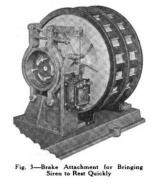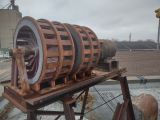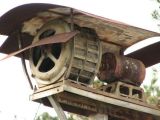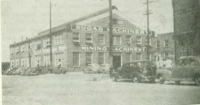William A. Box Iron Works Co.
The William A. Box Iron Works Company, formerly the Dillon Box Iron Works Company, was a Denver, CO-based metalwork company founded in 1902 by William Alfred Box and Frank Dillon, which manufactured electric traveling cranes, mining machinery, and railway crossing alarms. They are most notable for their Denver sirens, which are known for their rarity, historical significance, and unique design. William Box is credited as the inventor of the electric siren widely used today.
History

In 1902, the Dillon Box Iron Works Company was formed in Denver, CO, headed by William A. Box, who emigrated to Denver in 1896, and Frank Dillon. It was found at the time that the numerous steam whistles and fire bells used at the time were confusing and sought to create a siren that would be noticeably distinct. The company experimented with creating electric sirens in 1905, most of which would prove to be a failure. In 1910, Frank Dillon left the company, and the business was renamed the William A. Box Iron Works Company. Box would find success with the Denver Type-A in 1915, alongside other Denver-branded sirens such as the Duplex and Quadruplex which were also patented in 1915. The rotors on the sirens were directional (similar to ACA's sirens) and were the first electric sirens to have true directional rotors, louder when running counterclockwise. Metal arrows were bolted to the front stator to assist with correct installation. Some of the sirens used single-cast stators, while others used 2-piece stators bolted together.
Despite lacking any sort of protection from the elements, Box's sirens were incredibly well-built and durable, with many units surviving over 100 years in the elements despite lacking any cover for the rotors and stators. Despite the company being renamed, all Denver sirens built before 1918 were tagged with the original Dillon Box Iron Works name. After 1918, all tags would read WM. A. Box Iron Works Co. The sirens would be marketed and distributed by the Hendrie & Bolthoff Mfg. Co of Denver Colorado, American LaFrance Co of Elmira, New York, Duluth Electrical Supplies Co of Duluth, Minnesota, and Northern Fire Apparatus Co of Spokane, Washington, and Woodhouse Manufacturing Co, of New York, New York. William A. Box Iron Works would continue to produce the Denver sirens, as well as a wide variety of other products, until 1931, when its founder, William A. Box, unfortunately passed away of complications from an operation after years of illness.
Today, Box's Denver sirens are surprisingly widespread considering most units are well over 100 years old. Some found use as fire sirens and remain next to their fire stations. Most are still hooked up to power, although unused. Many sit inside custom-built shelters to protect them from the elements, as their rotors are completely exposed and unprotected otherwise. Notable locations include Lebanon, TN, Jerome, AZ (near a Cosgrave siren), and Friendsville, TN. The vast majority of surviving Denver sirens are Duplex and Quadruplex models, with roughly 24 of each unit surviving today, with even fewer being active. 3 Denver Type-As remain in existence, while only a single inactive Type-B survives.
Products
Type-A

Introduced in 1915, the Type-A was Box's earliest successful attempt at creating a large electric single-headed siren after many years of trial and error. This siren has the distinction of being the first successful large-scale electric siren ever produced. While earlier electric sirens existed, such as Pearse and Heath's sirens, neither reached the Denver's level of widespread adoption. The siren uses a pair of 12-port rotors and stators attached together, which were both driven by a single-sided 1.5 or 2 hp AC motor running at 1750 rpm, which was only available in 1 ph AC. Unlike the other siren models, this siren used a belt-driven gearbox containing a gear reduction drive to connect the motor and the rotor, with the motor being located parallel to the gearbox. This was due to the lack of acceptable electric motors that could reach an effective number of rpm at the time. The siren's rotors are suspended between 2 supports which have bearings on top, which keep the rotor in place. Due to the additional components included, the siren's rectangular motor cover is significantly larger than other Denver sirens. The siren was deemed to be maintenance intensive and did not perform very well, which led to it being redesigned in 1914. The gear reduction drive was removed, and the motor was coupled directly to the rotor, just like the Type-B. None of these transmission drive sirens exist today. The 1914 redesign saw the reduction drive being removed, and the motor was directly coupled up to the rotor to simplify the design. This made the siren more compact and less mechanically complex, which helped remedy the issues operators had with the transmission drive units. Early Type-A units used staggered rotor and stator ports, though by 1920 this was changed to being non-staggered with a simpler rotor design. This design would be used until the Type-A was discontinued. 3 Denver Type-A units are known to survive today, one being an earlier staggered rotor unit in Canova, SD, while another is a later simplified unit located in Kanorado, KS. The third survives atop the roof of the Rockford Manufacturing Plant in Rockford, TN.
Type-B

The Type-B was an improved version of the Type-A, with several design changes to improve its performance. The siren is driven by a single 2 hp AC motor at 1740 rpm, and the siren is equipped with a single (or optionally, a double-sided) 20-port single-tone rotor and stator. The extra bearings and supports that the Duplex uses are not included, and the rotor is directly coupled to the motor instead. As a result, the Type-B is much more compact than a Duplex, which makes it more useful where larger sirens are impractical. The Type-B was designed primarily for marine use and was optionally available with a 150 V DC motor, which was designed for use on motor ships that could not use steam whistles. The motor ship Kennecott was one such vessel that was known to be equipped with one of these sirens, though the vessel was wrecked after running aground in 1923. The Type-B has only a single surviving example, a dual rotor variant located in Ferriday, LA.
Duplex


The Duplex was the main single-headed siren sold by William A. Box Iron Works, introduced in 1914, and was a single-headed siren with a pair of 20-port single-tone rotors and stators bolted together, suspended between 2 supports that held bearings to keep the rotors in place. These were driven by a single-sided 3 hp AC motor running at 1750 rpm, available in either 1 or 3 ph AC. Early models used 20 long vanes on each rotor, though sometime after 1916, this was changed to 5 long vanes and 15 short vanes. A large, rounded motor cover protects the motor from the elements, and everything is attached to a long frame. These would be produced until William Box died in 1931. These were less common than the larger Quadruplex, and few of these survive today, some still hooked up to power but unused. A special coded Duplex was also offered for a short period, equipped with a large electromagnetic drum brake, which brought the siren to a quick halt, not dissimilar from a Sterling Code Siren. None are known to still exist. A variant also existed which was designed for use on motor ships.
Quadruplex

The Quadruplex is a dual-headed version of the Duplex that was introduced in 1914 and was the most popular siren that was sold by William A. Box Iron Works. These are essentially a Duplex with an additional pair of rotors and stators in front of the other 2, which would theoretically increase sound output. Due to the added weight of the extra rotors, an additional support and bearing are located at the front of the siren, with the siren's overall length being significantly longer. The Quadruplex uses 4 20-port rotors and stators, driven by a single-sided 3 hp or 5 hp AC motor running at 1750 rpm, and was available in either 1 or 3 ph AC. The 5 hp model was recommended by the company for sirens which would run multiple consecutive cycles, which would put more wear on the motor. Early models used 20 long vanes on each rotor, though sometime after 1916, this was changed to 5 long vanes and 15 short vanes. A large motor cover helps protect the motor from the elements, and everything is attached to a long rectangular frame. The Quadruplex is tied with the Duplex as the most common Denver siren surviving today, with several being left in place due to the difficulty of removing such a large siren. These would be produced until William Box died in 1931. Many were used as fire sirens before being retired, though some are still hooked up to power and used as a backup for more modern methods of summoning firefighters. Others are used as noon whistles.
Center Drive Duplex
The Center Drive Duplex was a dual rotor siren that was first produced in 1925 and was significantly more compact than most of the Denver siren models. The Center Drive Duplex was a 6/6-port single-tone siren, using 2 6-port rotors driven by a single dual-shafted 5 hp motor in between, running at 3000 rpm. These sirens were intended to compete with the very popular Sterling Model M and Federal Electric Type Mach. B which was outselling older Denver designs by a large margin. The siren's rotors have 3 long vanes, which would produce a significant undertone. The siren was available with a protective cover attached to the bottom mount, which would protect the siren from rain and debris. The Center Drive Duplex would only be produced for 6 years, as William Box died in 1931 which led to all of his sirens being discontinued. Only one of these sirens has ever been documented, on the old fire station in Wheat Ridge, CO. The fire station was demolished long ago, with the siren disappearing along with it, and they are now considered extinct.
Boxco sirens
The Boxco sirens are small sirens created by William Box in the 1910s, with several prototypical contraptions being developed as early as 1905. These sirens were sold separately from the other Denver products under the "Boxco" brand. The sirens came in electric and hand-cranked variants and saw use as a mine whistle, shift-change alarm, or a vehicular siren. The electric variant of the siren is relatively simple, with the 12-port rotor and stator above a small AC motor, with a stand attached to the bare motor which allows the siren to be mounted. The siren features no protection from the elements, like most of Box's sirens. How its hand-cranked counterpart operated, or what it looked like for that matter, has unfortunately been lost to time, with none of these units surviving. Few of these Boxco sirens still exist.
Boxco Suspended Siren
A variant of the Boxco electric/hand-cranked siren that was created by William Box, the Suspended Siren is a small single-rotor siren that was uniquely designed to hang from a ceiling or wall fixture. These sirens were equipped with an eyebolt attached to the motor which allowed it to be hung from a hook or suspended on a wire. The siren uses a single 6-port rotor and stator which is located below the motor. These sirens were likely designed for use in industrial areas or mines, where a small, easy-to-install and replace siren was desirable. Little else is known about this siren, and no units likely exist.
Interstate Sterling Duplex and Quadruplex

In 1917, the Interstate Machine Products Company (which would later become the Sterling Siren Fire Alarm Company) sold their own variants of the Denver Duplex and Quaduplex sirens presumably under license or heavily inspired by William Box Iron Works' designs. They were available exclusively in 20/20-port (or 20/20/20/20-port for the Quadruplex) single-tone and dual-headed models that could have coding mechanisms attached to the stators. Like their Denver counterparts, the Sterling Duplex and Quadruplex use a dual-sided rotor/stator coupled to one or both sides of the motor, with the motor being placed on a raised stand resembling those used on the Model M. A small, rounded motor cover protects the motor, while a sounder is placed on top of each stator to direct the sound downwards. The siren as a whole is attached to a single long frame, making this unsuitable for pole mounting, but perfect for roof mounting. Unlike the Model M, the Duplex and Quadruplex have the chopper coupled to the motor through a clutch, rather than directly coupling the rotor to the motor.
These would be discontinued in the early 1920s in favor of the superior Model M, which was weatherproof and more compact. Interstate Duplex and Quadruplex units are now extremely rare, as all surviving units are over 100 years old. The Quadruplex in particular is technically extinct, as any original Quadruplexes that have survived to the present day have since been converted to Duplexes. The last known fully intact unit has also since been destroyed, leaving only a handful of Duplexes and a converted Quadruplex in existence. While no Duplexes are known to be active, one converted Quadruplex unit in Wisconsin appears to be active though this is unconfirmed. Its rotors appear to have moved when compared in different photos, which suggests it is still in use.
Gallery
-
William Alfred Box (1873-1931).
-
The Center Drive Duplex, as advertised with its protective housing.
-
An early Boxco electric siren.
-
The Boxco Suspended Siren, as advertised.




